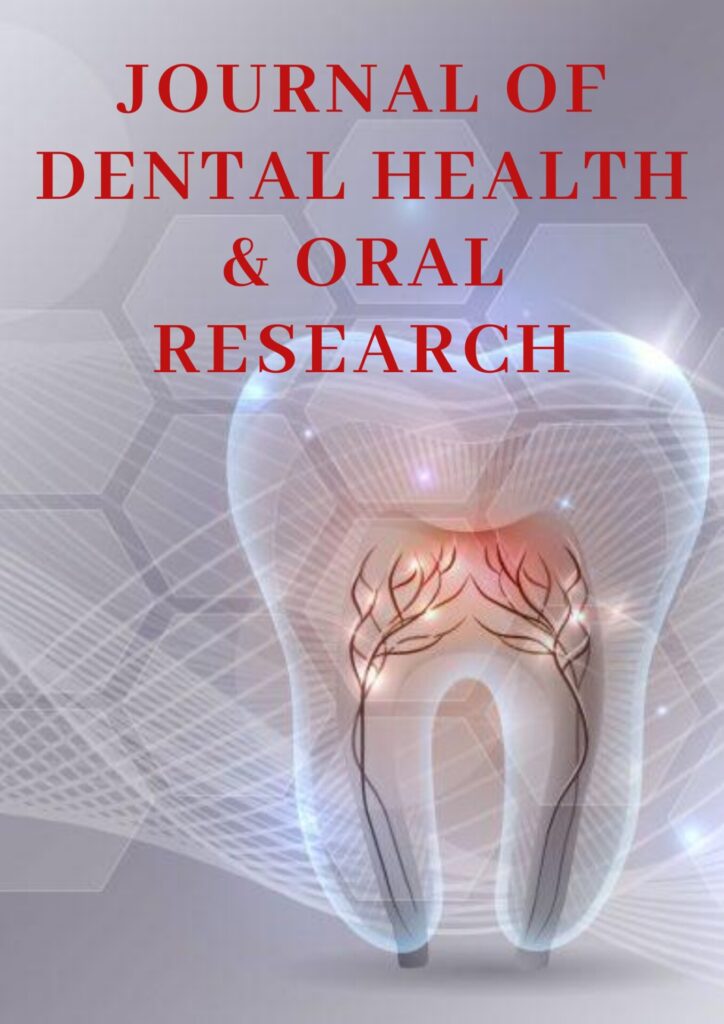|
Review Article | Vol. 6, Issue 1 | Journal of Dental Health and Oral Research | Open Access
|
Basis for Modern and Standardized Endodontic Therapy
Abdelhamied Y Saad1*
1Professor of Oral Biology/ Endodontics, College of Oral and Dental Surgery, Misr University for Science and Technology (MUST), Cairo, Egypt
*Correspondence author: Abdelhamied Y Saad, BDS, MS (Egypt), Ph.D., Professor of Oral Biology/ Endodontics, College of Oral and Dental Surgery, Misr University for Science and Technology (MUST), Cairo, Egypt;
E-mail: [email protected]
Citation: Saad AY. Basis for Modern and Standardized Endodontic Therapy. J Dental Health Oral Res. 2025;6(1):1-32.
Copyright© 2025 by Saad AY. All rights reserved. This is an open access article distributed under the terms of the Creative Commons Attribution License, which permits unrestricted use, distribution, and reproduction in any medium, provided the original author and source are credited.
| Received 21 December, 2024 |
Accepted 13 January, 2025 |
Published 20 January, 2025 |
Abstract
The purpose of this educative work was to evaluate the goal of endodontics, indications and contra-indications of endodontic treatment, criteria of success, causes of failure, as well as one appointment vs. multiple appointments therapy and prognosis. This teaching materials was collected from some endodontic text books, researches, internet, CrossRef, Google scholar database, Midline and from My personal educative materials to make a complete story concerning “Modern Endodontic Therapy”. The results demonstrated successful outcome with long term follow-up. It was concluded that careful clinical and radiographic examination should be performed, correct diagnosis and subsequent proper therapy should be achieved and long-term follow-up is required to obtain successful results.
Keywords: Contra-indications; Indications; Modern Endodontics; Pain; Retreatment; Single Vs. Multiple Visits; Success and Failure
Introduction
Definition of Endodontic: The best definition may be modified from the definition by the American Association of Endodontics.
“Endodontic is that branch of dentistry that is concerned with morphology, biology, physiology and pathology of human dental pulp and periradicular tissues. It is also concerned the etiology, diagnosis, prevention and treatment of diseases and injuries of the pulp and associated periradicular conditions”.
Therefore, Endodontics means:
- A total chemo-mechanical debridement of the pulp space and a total obliteration of the root canal in three dimensions to develop of a fluid tight or “hermatic seal” at the apical foramen. Moreover, The goal of endodontics is:
- To remove the intracanal source of Irritants
- Leading to periradicular improvement
- Keeping the dentition in a good physiological and functional state
- To Maintaine the oral and systemic health [1]
Indications (according to some investigators)
- When the pulp is irreversibly inflamed or necrotic (Fig.1-3)
- When the tooth cannot be properly restored without pulp removal (e.g. hyper-erupted or drifted molar) (Fig. 4)
- When teeth in the path of radiation
- In conjunction with periodontal therapy, including root amputation, hemisection and bisection (Fig. 5-8)
- When the tooth is important to serve as an abutment for prosthesis (Fig. 9)
- To reduce the usual ridge resorption (e.g. overdenture) (Fig. 10)
- Coronal fractures with pulp involvement (Fig. 11,12)
- Following traumatic dental injury (Fig. 13,14)
- Due to medical reasons: endodontic-treatment is less traumatic than extraction, such as in:
- Rheumatic fever and rheumatic disease
- Other heart diseases (Prophylactic umbrella of antibiotic
- is recommended)-Subacute bacterial endocarditis may occur
- Controlled diabetes
- Chronic leukemia and cancer
- B. and syphilis.
- Pregnancy [2-4]
Contraindications
- When the patient is too young (uncooperative) or too old (calcified canals are difficult and slower in healing) (Fig. 15)
- Medical reasons (e.g. Active diabetes and severe anemia (Repair may not occur or delayed)
- When the tooth is not strategic to the dental health of the patient (e.g. wisdom tooth)
- When the tooth cannot be maintained periodontally and severely mobile.
- Badly broken down tooth by caries and cannot be restored (Fig. 16)
- Badly fractured tooth (Fig. 17)
- Tooth with tortuous or bayonet-shaped canal (Fig. 18,19)
- (use fine sharp instruments, EDTA, R-C prep or NiTi rotary instruments may help)
- Tooth with advanced pulp recession (use surgical bur-14mm in length- may help) (Fig. 20)
- Tooth with broken instrument in the canal (may serve as an adequate filling and may be bypassed (Fig. 21,22)
- Tooth with procedural root perforation (especially in a palatal or lingual position). Perforation may be repaired by Ca(OH)2, MTA or surgical approach (Fig. 23,24)
- Tooth perforated by internal or external root resorption (surgical approach can be used) (Fig. 25-28)
- Patient with limited mouth opening due to TMJ disorder (Fig. 29)
- When the operator’s skill is not commensurate with the task
- When the patient is unable to pay for the therapy
- Tooth with incompletely developed apex and dead pulp (apexification*, apexogenesis** or pulp revascularization*** should be attempted first) (Fig. 30 -32)
Note: * Apexification: Is the induction of a calcific barrier or the creation of an artificial barrier across an open apex of an immature necrotic tooth using Ca(OH)2 or MTA [Internet].
** Apexogenesis: Is a procedure where vital tissues within the tooth is maintained to facilitate continued development of the immature root. A portion of inflamed pulp is and filled with a bioceramic materials like MTA and Biodentine that maintained vitality in the root. Heathy tissue then allows for continued root development. Ca(OH)2 can also be used. Furthermore, platelet-rich plasma and platelet-rich fibrin showed better results [Internet].
*** Pulp revascularization: Is a regenerative endodontic procedure “in which a new pulpal tissue is expected to be formed from the tissue present in necrotic, immature permanent teeth (stem cells), allowing for the continuation of development of root using triple or double antibiotic past and tissue engineering technology” [Internet].
- Tooth with persistent excessive periapical exudate that cannot be controlled before obturation (irrigation, intracanal medication and obturation directly followed by surgery)
- When the patient has no motivation to maintain the tooth [2,3,5-8]
Endodontic Success and Failure
Numerous researchers seem to agree that:
- A high success rate is associated with vital inflamed pulp compared to that of the non-vital pulp with area of rarefaction (Fig. 33,34)
- A high success rate is associated with flush-filling or overfilling
- Symptomatic cases were twice to fail as were asymptomatic cases (10.6% versus 5.0%) [2,3,5,6]
Causes of Failure: Several investigators were summarized cause of failure as follows:
- Apical percolation: Defined as constant leakage of transudate or serum into the unfilled or partially filled canal, which degraded slowly, diffuse out to the periradicular tissue and acts as an inflammatory irritant to produce persistent apical periodontitis and endodontic failure with absence of bacteria. Serum furnishes nutrient materials for microorganisms in primary infected root canal. Percolation represents greater cause (60 %) of endodontic failure (Fig. 35-41).
- Operative errors due to:
- Root perforation
- Broken instrument
- Canal grossly overfilled
- Remaining caries (Fig. 42-45)
- Errors in case selection
- Cases with severe internal or external root resorption
- Concomitant endodontic-periodontic lesion
- Developing apical cyst
- Adjacent pulpless tooth
- Accessory canal unfilled
- Constant trauma (bruxism)
- Split tooth (46-50)
- Errors during endodontic surgery due to:
- Foreign body left in the periapical area following surgical procedure (Fig. 51)
- Use of amalgam containing zinc as a retrograde filling (causes constant electrolysis and expansion fracture) [2-4,9,10]
Criteria for the Success of Endodontic Treatment
Clinical Criteria
- The mucosa should be normal in structure, color, free of swelling or fistulous tracts
- The periodontal space and the attachment apparatus should be normal and free of any pocket formation of endodontic origin
- The tooth mobility should be within physiologic range
- The soft tissue should respond normally to palpation and not fluctuant or tender
Radiographic Criteria
Upon completion: Radiograph should show:
- A complete root canal should be clearly reproduced on a good quality radiograph
- The access cavity should be continuous with the chamber cavity and both should blend and flow with the root canal outline itself
- The radiograph should show that all cavity spaces are densely filled
- The access cavity and the clinical crown should be free of any perforation, gouges or caries
- The root canal should be filled to 0.5-1.0 mm from the radiographic apex
- The cervical zone of the root canal should have a visible, uninterrupted radiographic flare
- The root canal should be free from any obstruction e.g. ledges, broken instruments, perforations or foreign-body particles
- The root canal filling should demonstrate uniform radiographic opacity throughout its dimensions with no visible voids
- Root canal material should be confined within the tooth (Fig. 52-54)
Upon recall: Radiograph should show:
- The root end should be free of any visible resorption that was not present at the time of completion
- The periapical bone should be normal in appearance and structure
- There should be no new radiolucency development
- The original radiolucency should be reduced in size or disappear (Fig. 55-57)

Figure 1: Necrotic pulp with periapical lesion.
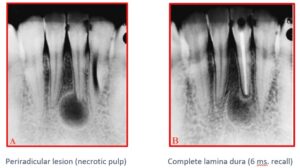
Figure 2: Complete lamina dura (6 ms. recall).
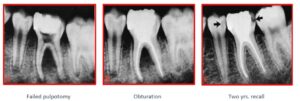
Figure 3: Pulpless first molar following failure of pulpotomy.
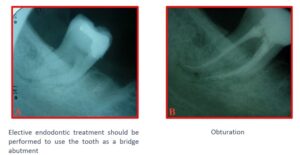
Figure 4: Hyper-erupted and mesially drifted molar.
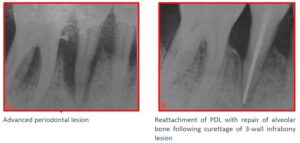
Figure 5: Advanced periodontal lesion and necrotic pulp.
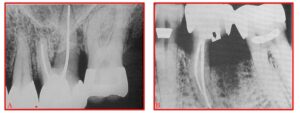
Figure 6: Root amputation.
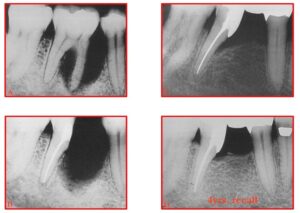
Figure 7: Tooth hemisection.
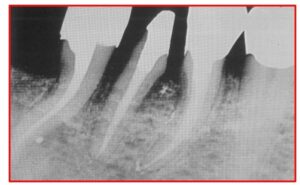
Figure 8: Bisection of 1st molar and hemisection of 2nd molar.
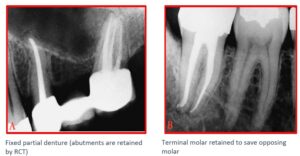
Figure 9: Terminal molars saved by endodontic therapy.
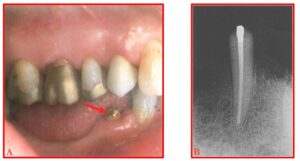
Figure 10: Overdenture; alveolar bone remaining around retained canine.
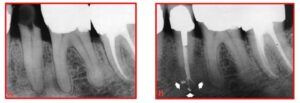
Figure 11: Root canal treatment with post restoration.
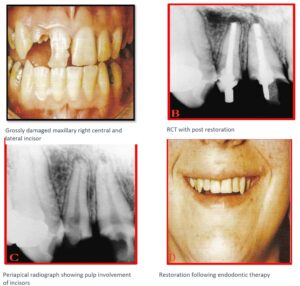
Figure 12: Coronal fracture with pulp involvement.
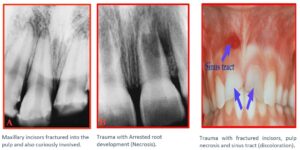
Figure 13: Following trauma with pulp involvement and arrested root development with sinus tract. 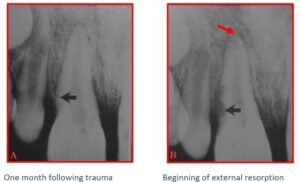
Figure 14: Following trauma with pulp involvement and external resorption.
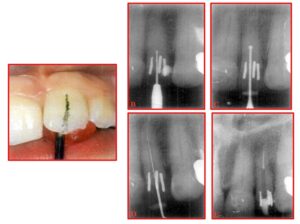
Figure 15: Calcified canal. Use fine bur and small file may help.
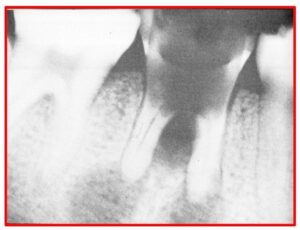
Figure 16: Hopeless tooth which is badly destroyed by caries.
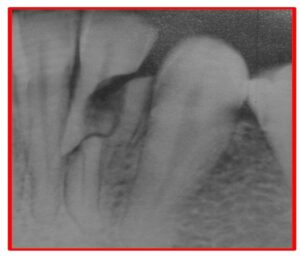
Figure 17: Tooth needs extraction.
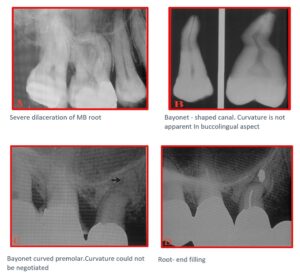
Figure 18: Teeth with abnormal root shape.
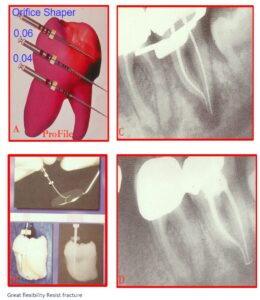
Figure 19: Curved canals can be negotiated using NiTi flies.
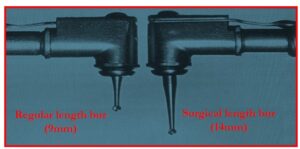
Figure 20: Regular and surgical burs.
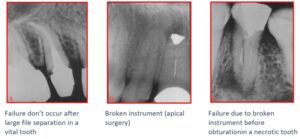
Figure 21: Periapical radiographs showing broken files inside root canals.
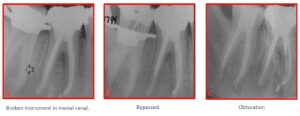
Figure 22: Periapical radiographs of mandibular molar showing broken files which bypassed and the canal subsequently obturated.

Figure 23: Massive perforation (extraction).
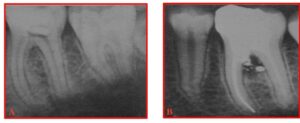
Figure 24: Perforation is revealed after endodontic treatment is completed. For repair use cavit, amalgam, Ca(OH)2 or MTA before treatment.
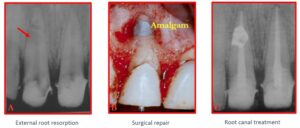
Figure 25: External resorption treated surgically.
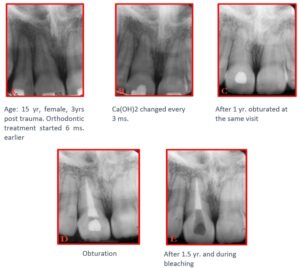
Figure 26: External resorption treated conventionally by Ca(OH)2.

Figure 27: Internal resorption with perforation treated surgically.
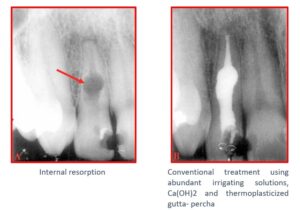
Figure 28: Internal resorption treated conventionally before perforation.
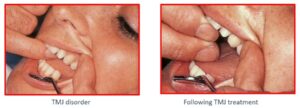
Figure 29: Endodontic treatment is difficult in patient suffering from TMJ problem.
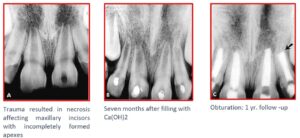
Figure 30: Apexification using Ca(OH)2.
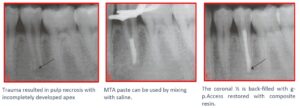
Figure 31: Apical closure with an artificial barrier.
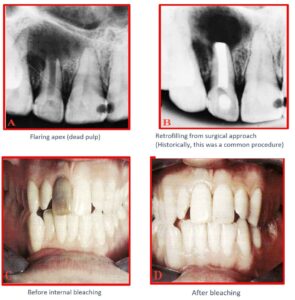
Figure 32: Surgical treatment of traumatized incisor with necrotic pulp and incompletely developed apex.
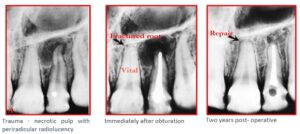
Figure 33: Successful case.
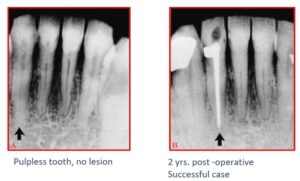
Figure 34: Another successful case.
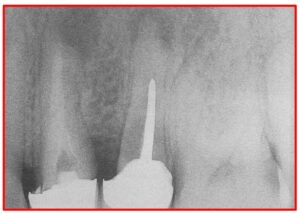
Figure 35: Inadequate root canal treatment and caries in the second premolar.
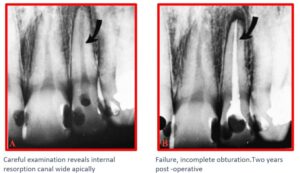
Figure 36: Failed case.

Figure 37: Failure in obturation.
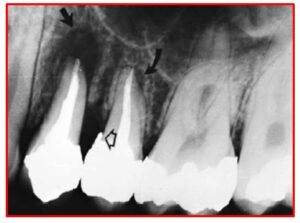
Figure 38: Failed cases, defective amalgam, and inter-proximal lesion, two years post -operative.
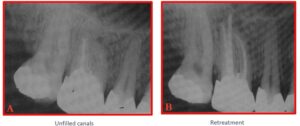
Figure 39: Failed case due to missed canals. Successful result obtained after retreatment.
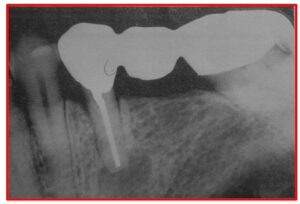
Figure 40: Failure after 20 year with silver point. Breakdown of sealer and percolation.

Figure 41: Failed case due to obturation with silver point.
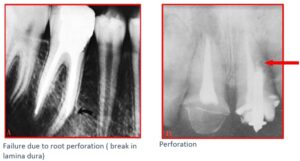
Figure 42: Failed cases due to perforation.

Figure 43: Another failed cases.
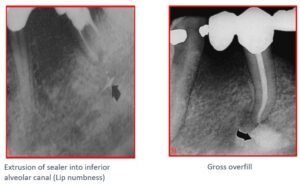
Figure 44: Another failed cases due to gross over filling.
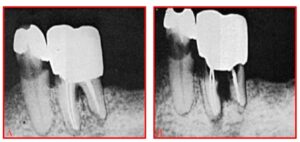
Figure 45: Post-operative failure due to caries.
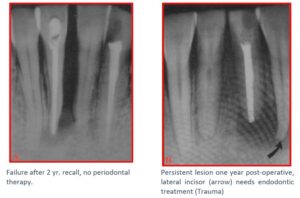
Figure 46: Another failed cases.
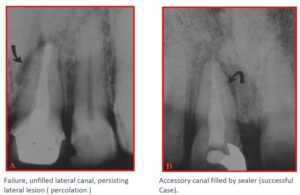
Figure 47: Another failed and successful cases.
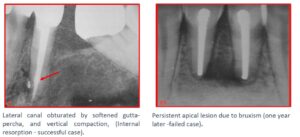
Figure 48: Another failed and successful cases.

Figure 49: Failed cases due to root fracture from excessive lateral compaction force.

Figure 50: Verticle fracture, tooth needs extraction.

Figure 51: Foreign body left in the periradicular area after suturing the flap.
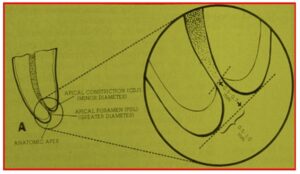
Figure 52: Gutta-percha should be extended to 0.5-1.0 mm from the radiographic apex.
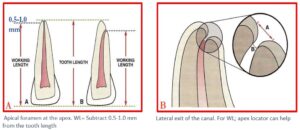
Figure 53: Ideal termination of canal preparation and obturation.
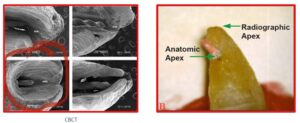
Figure 54: Overextended filling.
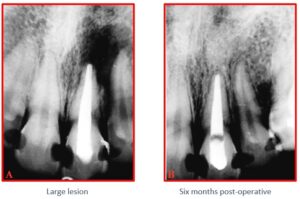
Figure 55: Good obturation with follow-up.

Figure 56: Another case showing good obturation with follow-up.
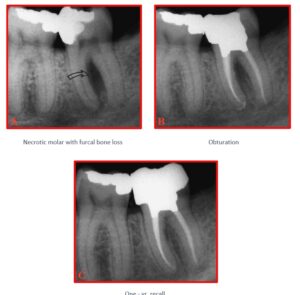
Figure 57: Successful obturation with follow-up. Furcal healing was occurred.
Biological Criteria
- The ability to tolerate the endodontic treatment should be considered
- The inflammatory process should be controlled by reducing bacterial contamination, instrumentation or by antibiotics
- The periapical and periodontal tissues should be protected from physical and chemical trauma (over-instrumentation and over-medication)
- The integrity of occlusal relationships should be considered by careful placement of temporary restoration [2,3,9,10]
Apical Patency and Its Preparation
- Apical patency is leaving the apical foramen clean, accessible, free from dentin chips, pulp fragments and other debris as well as bacteria to avoid apical blockage or infection and retaining true working length.
- This apical patency depending on:
- Irrigation with NaOCl and EDTA
- Using patency files, no. 10 or 15 0.02, after each enlarging instrument used beyond the working length, to the apical foramen [2,11,12]
Measures to be Employed to Improve Success Rate
- Great care in case selection
- Great care in treatment
- Adequate cavity preparation
- Determine the exact working length
- Use curved, sharp files in curved canals (NiTi files will help)
- Use great care in filling the primary point (master cone)
- Utilize periapical surgery only when indicated
- Restore the obturated tooth to prevent fracture
- Practice endodontic techniques until the procedures are as routine as the placement of an amalgam restoration
- Check the density of retrofilling (by explorer) during surgery, if found wanting, the apical foramen is retrofilled [2,3,13,16]
One-Appointment Therapy
- There are two controversies, The first deals with the efficacy of single visit therapy and the second is multiple visit protocol
- The literature shows no real difference in failure or pain by one appointment or with multiple appointments
Advantages of single visit Endodontic therapy:
- Immediate familiarity with the internal anatomy
- No risk of bacterial leakage between visits
- Reduction of clinical time
- Minimizes patient’s fear and anxiety
- Eliminates the problem of the patient who does not return to have the case completed
- Patient convenience- no additional visit
- Less cost
Disadvantages of single visit Endodontic Therapy:
- No easy access to the apical canal in flare-up
- Clinical fatigue with extended time
- Patient fatigue (TMJ problem)
- No opportunity to place intracanal medication
- The clinician may lack the expertise to properly treat a case in one visit (failure and flare-ups may occur)
- Difficult cases may not be treatable in one visit without causing undue stress
One-visit therapy should be considered in:
- Uncomplicated vital teeth
- Fractured anterior teeth for esthetics
- Patient who are unable to return for the completion
- Medically impaired patients who require repeated regimens of prophylactic antibiotics
- Necrotic uncomplicated teeth with no draining sinus tract
- Patients requiring sedation or operating room treatment
One-visit therapy should be avoided in: (as reported by several Investigators)
- Painful, necrotic teeth with no sinus tract
- Teeth with severe anatomic anomalies
- Symptomatic non-vital tooth with periapical radiolucency and no sinus tract
- Patient who has acute periodontitis with severe pain to percussion
- Most re-treatments [2,17-21]
Prognosis (as stated by numerous researchers)
Studies concerning endodontic prognosis and systematic review have revealed that it depends upon:
- Case selection
- Treatment quality (differ between general practitioners and endodontists)
- Absence of a periapical radiolucency improves the outcome of root canal treatment
- Sinus tract may have a significant effect an prognosis
- Success rate with periapical lesion: 72-85%
- Success rate may be enjoyed if there is no lesion
- Operator’s skill [2,8,16,22-26]
Referrals
When general dentist should refer an endodontic patient?
Referral to specialist is often helpful when planning treatment for difficult situations such as:
- The complex cases
- Emergencies e.g. toothaches, broken crowns, clinical, exposure or avulsed teeth (immediate treatment is needed)
- Medically compromised patients
- Mentally compromised patients
- If the general dentist believes that the task goes beyond his [2,3,25]
Endodontic Retreatment
There is lack of agreement concerning endodontic prognosis of retreatment cases. In a systematic review, it was suggested that the outcome of retreatment cases should be similar to treatment cases as long as access to the apical infection can be re-established [26], furthermore, a retreatment plan should be developed after the clinician has determined the cause of failure. Retreatment may require surgical endodontics in combination with nonsurgical retreatment [2,26]. Recently, Choudhari, et al., in their systematic review and Meta-analyses aimed to critically evaluate the outcome of single-visit versus multi-visits endodontic retreatment in patient with secondary infections. In conclusion, they stated that comparative analyses indicated that single-visit endodontic retreatment yielded comparable postoperative pain levels and healing outcomes as retreatment conducted over multiple-visits. They added that the utilization of intracanal medicaments such as calcium hydroxide and triple antibiotic paste demonstrates promise in mitigating postoperative pain subsequent to retreatment procedures [27].
Post-Operative Pain
The literature shows no real difference in pain experienced by patients treated with multiple appointments. In addition, necrotic cases treated in one visit have more flare-ups [2,17-19,22,25]. Oliet revealed that only 3% of his cohort of 264 patients receiving single-appointment treatment had severe pain, compared with 2.4 of 123 patents treated in two-visits [28]. Pekruhn and Fava have reported no statistically significant difference between their two groups and Trope demonstrated no flare-ups in one appointment cases with no apical lesions [19,29]. However, retreatment of failed cases with apical periodontitis made the difference. These cases suffered a 13.6% flare-up rate [18]. Al-negrish and Habahbeh showed more flare-ups occurred in the two appointments group (13.8%) than in the single visit group (9.2%). Flare-ups occurred after 2 days and 7 days, 5.2% and 1.8%, respectively [23]. In general, one expects post-operative pain from any case as stated by Harrison, et al., [30].
Discussion
Recently, there is no question that the publics and milions of patients accepting endodontic treatment over extraction. The growth in endodontic serves is also reflected in the sales of endodontic supplies, equipment and instrument [1,2,11,25]. Moreover, successful root canal therapy requires a thorough knowledge of root canal morphology. Root canal treatment may fail if root canal system is not fully identified and not properly treated. Therefore, a thorough knowledge of both normal and abnormal morphologic variation is required as supported by several investigators [2,3,13-15,25].
Numerous researches, in the current work, focused on indications and contra-indications of endodontic treatment and discussed the criteria of success and causes of failure. They revealed that every tooth is a potential candidate for treatment. Extraction of a pulpless tooth is short-sighted attempt to solve the dental problem. They added that any tooth with pulpal involvement, provided that it has adequate periodontal support. can be endodontically saved and overdenture can be recognized [2-4,25,27]. On the other hand, tooth extraction must be performed if the tooth is hapless, severely destroyed and cannot be maintained periodontally [2,3,5-8]. In this situation, fixed bridge or removable prosthesis or even endodontic implant can be considered [2,3,25,26].
The present investigation compared and evaluated the results of single-visit versus multiple-visit endodontic treatment and retreatment in patients with secondary infection. There is a debate concerning this issue. Some clinician treats all cases in a single visit, regardless of the patient’s symptoms or complexity of the case. Others believes in multiple visit technique. However, the condition of the pulp and periradicular tissue, the number of roots, severity of symptoms, swelling or intervisit use of antimicrobials and clinician’s skills are factors to be considered. Treatment in such cases should be directed all alleviating pain, with obturating the canal for a subsequent visit to determine the effect of treatment on inflamed and infected tissue. Different in research, methodology may explain the conflict in their findings. Moreover, regarding the healing, there was no detectable difference between the two techniques [2,17-21,25-30]. These data were recently supported radiographically by Theodoridis and Economides after at least one year of follow-up and no significant difference in healing rate [31].
Conclusion
From the scope of this investigation, one should know that:
- Correct treatment begins with a correct diagnosis
- Differential diagnosis and treatment of oral pain of pulpal on Periradicular origin should be handled correctly
- Correct access cavity, proper instrumentation and irrigation. following the apical limit of root canal
- Apical patency and obturation in three dimensions should be performed
- Periodic follow-up examination should be achieved especially in teeth with apical periodontitis
Conflict of Interest
There are no potential conflicts of interest to declare in this paper.
Ethical Consideration
This investigation was conducted after obtaining the approval of the Research Ethic Committee, College of Oral & Dental Surgery, Misr University for Science and Technology (MUST), Cairo, Egypt.
Funding
The author reported that there is no funding associated with publication of this article.
Author Contributions
All authors contributed equally for this paper.
References
- American association of endodontists. definition of endodontics. AAE Membership Roster. 2005-2006.
- Ingle JI, Slavkin HC. Modern endodontic therapy: past, present, future. in: ingle’s endodontics. 6th, B C Decker Inc., Hamilton, Ontario L8N3K7. 2008;1-35.
- Grossman LI. Rational of endodontic treatment. In: Grossman’s Endodontic Practice. Wolters Kluwer Health. (India). 14th 2021;44-52.
- Lord J, Teel S. The overdenture: patient selection, use of copings. J Prosthet Dent. 1974;32(1):41-51.
- Saad Ay, Clem WH. Calcium hydroxide and endodontic therapy. Postgrad Dent. 1993;3:129-33.
- Saad AY. Calcium hydroxide and apexogenesis. Oral Surg. 1988;66:499-501.
- Saad AY. Calcium hydroxide in the treatment of external root resorption. JADA. 1989;118:579-81.
- Saad AY. Role of stem cells in revascularization of necrotic permanent tooth with immature apex. J Dent Health Oral Disord Ther. 2017;6(6):1-17.
- Saad AY, Clem WH. An evaluation of etiologic factors in 382 patients treated in a postgraduate endodontic program. Oral Surg. 1988;65:91-3.
- Saad AY, Clem WH. The use of radiographs in periapical surgery. Oral Surg. 1990;69:361-5.
- Inoue N, Skinner DH. A simple and accurate way of measuring root canal length. J Endod. 1985;11(10):421-7.
- Sousa RA. The importance of apical patency and cleaning of the apical foramen on root canal preparation. Braz Dent J. 2006;17(1):6-9.
- Schilder H. Filling root canal in three dimensions. Dent Clin North Am. 1967;11:723-44.
- Langland K, cited in Riccuci D. Apical limit of root canal instrumentation and obturation. Int Endod J. 1998;31(6):384-93.
- Schaeffer MA, White RR, Walton RE. Determining the optimum obturation length: a meta-analysis of literature. J Endod. 2005;31:271-4.
- Yuan-Ling NG, Gulabivala K. Evaluation of outcomes. Cohen’s pathway of the pulp. 12th, Elsevier, St. Louis, Missouri, 2021;652-710.
- Landers RR, Calhoun RL. One-appointment endodontic therapy: an opinion survey. J Endod. 1980;6(10):799-801.
- Trope M. Flare-up rate of single visit endodontics. Int Endod J. 1991;24:24-6.
- Fava LR. A clinical evaluation of one and two-appointments root canal therapy using calcium hydroxide. Int Endod J. 1994;27(1):47-51.
- Figini L, Lodi G, Gorni F. Single versus multiple visits for endodontic treatment of permanent teeth: a cochrane systematic review. J Endod. 2008;34(9):1041-7.
- Trop M, Delano ED, Orstavik D. Endodontic treatment of teeth with apical periodontitis: single vs. multi- visits treatment. J Endod. 1999;25(5):345-50.
- Walton R, Fouad A. Endodontic intra-appointment flare-ups. A prospective study of incidence and related factors. J Endod. 1992;18(4):172-7.
- Al- Negrish A, Habahbeh R. Flare-up rate to root canal treatment of asymptomatic pulpally necrotic central incisor teeth in patient attending a military hospital. J Dent. 2006;34:635-40.
- Friedman S. Prognosis of initial endodontics therapy. Endod Topics. 2002;2:59-88.
- Rosenberg PA, Malek M, Okazaki K. Treatment Planning and Case Selection. In: Ingle’s Endodontics, Chapter 11, 7th, PMPH USA, Ltd. North Carolina. 2021;359-72.
- Ng YL, Mann V, Rahbaran S, Lewsey J, Gulabivala K. Outcome of primary root canal treatment: systematic review of the literature-part 2. Influence of clinical factors. Int Endod J. 2008;41:6-31.
- Choudhari S, Solete P, Jeevanandan Single-visit versus multi-visits endodontic retreatment: A systematic review of outcomes in patients with secondary endodontic infection. Saudi Endod J. 2024;14(3) 301-11.
- Oliet S. Single-visit endodontic therapy: a clinical study. J Endod. 1983;9(4):174-52.
- Pekruhn RB. Single-visit endodontic therapy. a preliminary clinical study, I Am Dent Assoc. 1981;103(6):875-7.
- Harrison JW, Baumgartner JC, Svec TA. Incidence of pain associated with clinical factors during and after root canal therapy. Part 1. Interappointment pain. J Endod. 1983;9(9):384-7.
Theodoridis A, Economides N. Single versus multiple visits endodontic therapy on healing rate of periapical lesions: A systematic review and meta-analysis. Balkan J Dent Med. 2023;27(3):140-7.
Author Info
Abdelhamied Y Saad1*
1Professor of Oral Biology/ Endodontics, College of Oral and Dental Surgery, Misr University for Science and Technology (MUST), Cairo, Egypt
*Correspondence author: Abdelhamied Y Saad, BDS, MS (Egypt), Ph.D., Professor of Oral Biology/ Endodontics, College of Oral and Dental Surgery, Misr University for Science and Technology (MUST), Cairo, Egypt;
E-mail: [email protected]
Copyright
Abdelhamied Y Saad1*
1Professor of Oral Biology/ Endodontics, College of Oral and Dental Surgery, Misr University for Science and Technology (MUST), Cairo, Egypt
*Correspondence author: Abdelhamied Y Saad, BDS, MS (Egypt), Ph.D., Professor of Oral Biology/ Endodontics, College of Oral and Dental Surgery, Misr University for Science and Technology (MUST), Cairo, Egypt;
E-mail: [email protected]
Copyright© 2025 by Saad AY. All rights reserved. This is an open access article distributed under the terms of the Creative Commons Attribution License, which permits unrestricted use, distribution, and reproduction in any medium, provided the original author and source are credited.
Citation
Citation: Saad AY. Basis for Modern and Standardized Endodontic Therapy. J Dental Health Oral Res. 2025;6(1):1-32.

